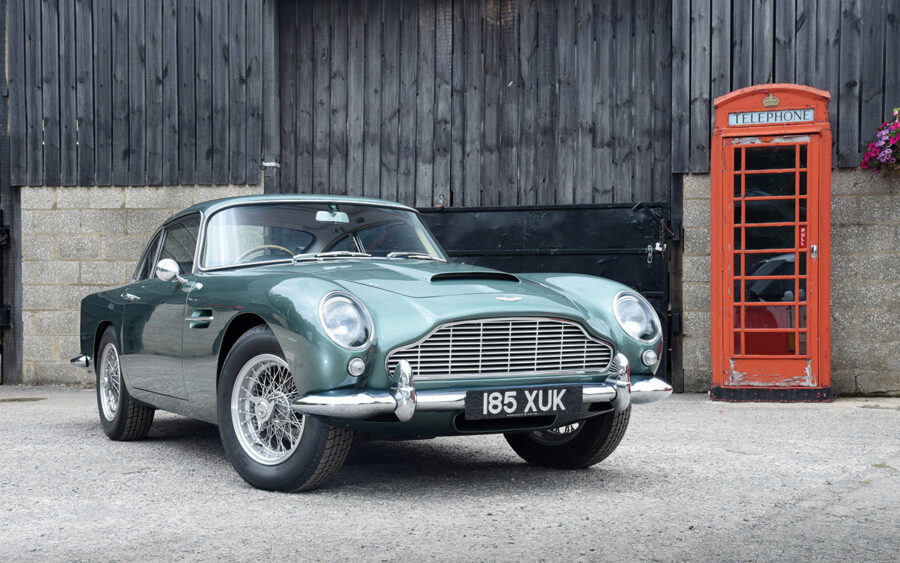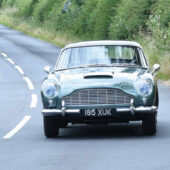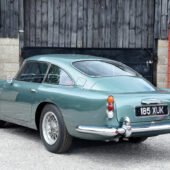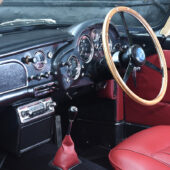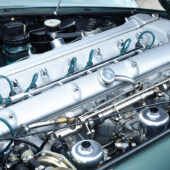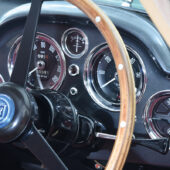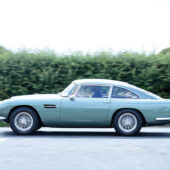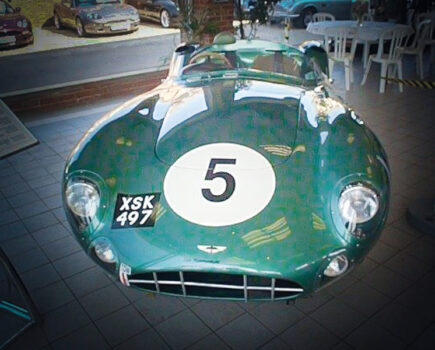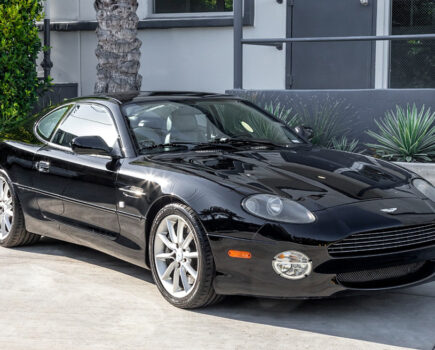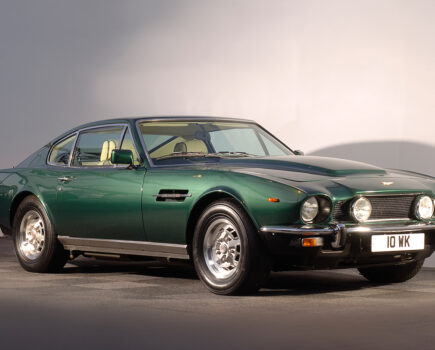With a longer body, faired-in headlights and distinctive shape, the DB4 Series V Vantage was a precursor to the DB5 that’s important and desirable in its own right
Words and images: Paul Walton
There have been some important models in Aston Martin’s long history; the 1915 ‘Coal Scuttle’ for example which was the original car to bear the name, or the first car under (Sir) David Brown’s ownership, the 2-Litre Sports. Then there’s the first V8 from 1969 and the 1994 DB7 that was the first model to be produced in serious numbers.
Yet these pale into insignificance compared to the importance of the DB4 Series V Vantage. Not only did it lay the foundations for the company’s most famous model, but it would influence all future designs. Park a current DB11 next to one and the family resemblance would be obvious. It was also one of the first Astons to be built at Newport Pagnell. Although production was tiny, we’ve tracked down a rare example to further explain its significance.
By the mid-50s, the DB2/4 was still well-regarded but, it was clear that in terms of performance and design it needed to be replaced. Aston’s management – which included the company’s owner, David Brown, plus its general manager, John Wyer – took the slightly unusual decision to head to Italy for the new car. Although others, including Pininfarina, were considered they eventually chose Touring having had recent contact with the Milan-based carrozzeria. In 1956 it had rebodied a DB2/4 Mk II into a distinctive two-seater, plus Wyer liked its Superleggera (Italian for superlight) construction method that consisted of aluminium panelling over a small-diameter steel-tube framework. It was placed over a rigid platform base designed by Aston’s chief engineer, Harold Beach.
With work starting in 1956, what Touring and Beach created was a large, handsome and imposing GT in the same mould as the Ferrari 250. At 14ft 8.375in long, 5ft 6in wide and 4ft 4in high, it was longer, wider and lower than the outgoing DB Mk III, making it appear much more purposeful. Shuttling between London and Milan during its creation, it was Beach who added the trademark wing vents used on every subsequent Aston.
Yet when the car was revealed at the 1958 London Motor Show at Earls Court, it wasn’t just the design that caused a sensation but so did its new engine. Even after it had been upgraded to 2.9 litres, David Brown realised the Lagonda unit that had powered the DB Mk III had reached the end of its development and so work started on a replacement. “I knew that we had a very good engine man, but he wanted to retire,” said Brown in Geoff Courtney’s 1978 book, The Power Behind Aston Martin. “So, we looked around and found a fellow called Tadek Marek working at Austin.”
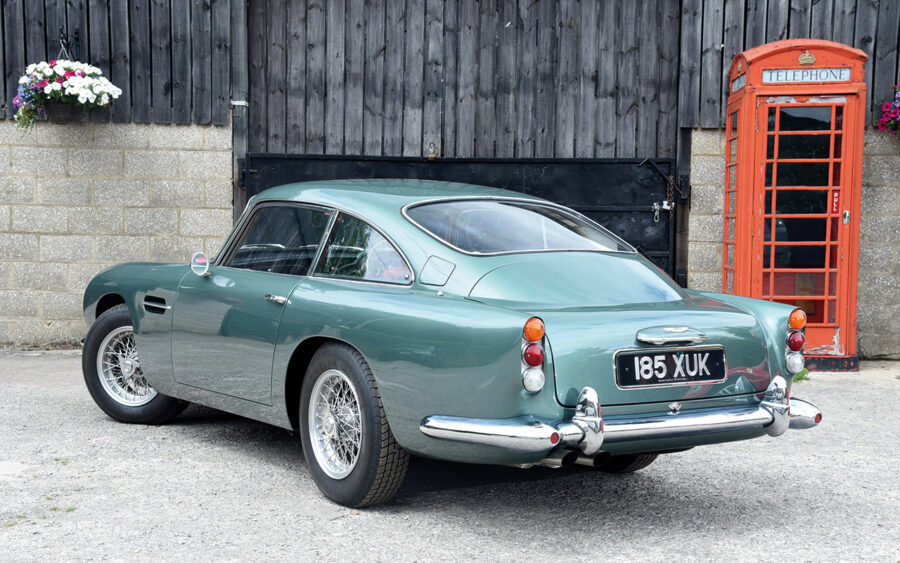
Born in Kraków in 1908 and a former student at Berlin’s Charlottenburg Technical Institute, Tadeusz ‘Tadek’ Marek started his career for Fiat in Poland and later General Motors. A keen racing driver, he entered the Monte Carlo rally three times between 1937 and 1939 in a Fiat 1100, Lancia Aprilia and Opel Olympia respectively before winning the 1939 Polish rally using a Chevrolet Master Sedan. The outbreak of war saw Marek join the Polish army, but he soon found himself in an internment camp and then a civilian refugee.
He travelled to the UK in 1941 and worked on the Rolls-Royce Meteor engine that powered the Centurion tank. After hostilities had ended, he spent two years unemployed before joining Austin in 1949 where he developed the C-Series six-cylinder engine that was used in a variety of cars including the Westminster, A90 and Wolseley. He joined Aston Martin in 1954 initially to update the Lagonda engine before starting work a year later on what would become his engineering masterpiece.
The first decision was the size of the engine. David Brown again; “We had a V12 Lagonda engine that had been designed by Eberan von Eberhorst, a former Auto Union man who joined us early in the Fifties and who was responsible for the DB3 competition car. We had constant crankshaft failures with this engine, however, and there was a lot of heart-searching as to whether we should try to rectify the errors and make this the replacement. We also did quite a lot of talking around the possibility of a V8 but eventually we opted for a six-cylinder.”
The eventual 3,670cc twin-cam engine featured an alloy block and head, a bore and stroke of 92mm and valves inclined at 80 degrees for better breathing. With a compression ratio of 8.25:1 and twin SU HD8 2in carburettors, power was quoted at 240bhp with torque around 240 lb ft. Marek’s new engine debuted in the DBR2 racing car in 1957 with the sole highlight being Aston-regular, Roy Salvadori, winning the 1957 Daily Express Trophy at Silverstone. Yet it was always destined for the DB4 that arrived the following year and made the new coupe genuinely fast; as well as being able to reach 60mph in nine seconds, it was the first production car capable of 0-100mph in under half a minute and able to reach the ton in 21 seconds.
“With a good open road ahead, or better, in competition on a circuit, the full use of the remarkable acceleration and speed can be used,” wrote Salvadori (who admitted to being an Aston driver at the start of his piece) in the May 1959 issue of Road & Track Magazine. “Never using more than 6,000rpm, you do about 54mph in first, 76mph in second, 108mph in third and 140mph in top (with a 3.54 axle ratio). Changing up at over 100mph, you still feel a definitive kick in the back as you accelerate in fourth.”
Thanks to its high speed and beautiful continental design, the DB4 put Aston into another league, making it a genuine rival to Ferrari, Maserati and Lamborghini. “The DB4 was a completely new, and a very brave and expensive step,” mused David Brown in 1978 for The Power Behind Aston Martin.
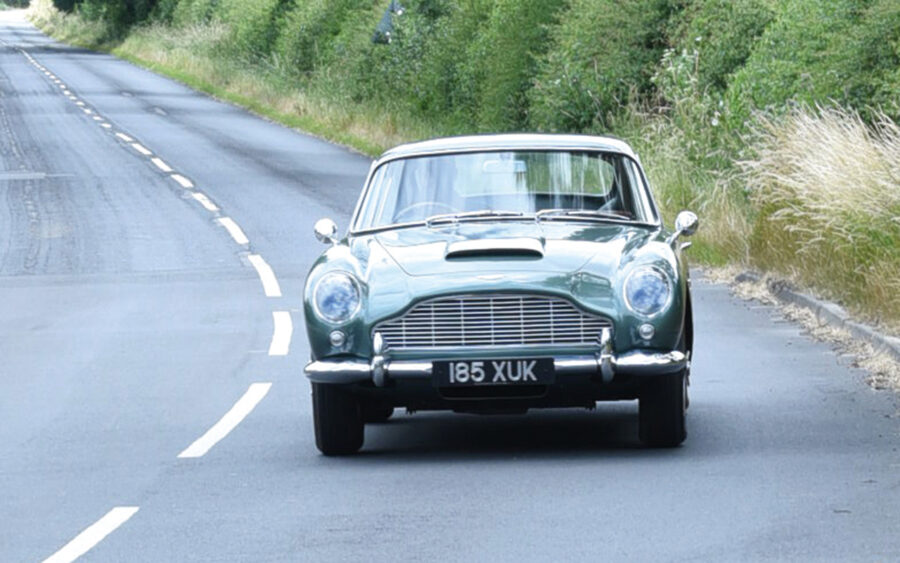
Since the took a mere three years to develop, it wasn’t without its issues, and it received four updates (unofficially known as Series) with the first arriving in early 1960 and the final one in September 1962. Series V was longer than the earlier models by 9cm (up from 448 to 457cm) and the roof was raised a little too, yet all within the same wheelbase as previous examples, which resulted in a longer boot and arguably better proportions. The diameter of the wheels was also reduced from 16 to 15in.
Aston had also developed two, even more performance-orientated models based on the DB4. The first arrived in 1959 and was the result of the International Trophy meeting at Silverstone holding a Grand Touring race for which Aston developed a faster version of its new machine. Powered by the ex-DBR3 3.0-litre engine, which had raced at that year’s Le Mans but had retired, it was identifiable by its headlamps set back into the wing beneath plastic cowls. Weighing 200lb lighter than the standard car and called the DB4GT, Stirling Moss won the race easily.
“All the closed road-going Aston s seemed muscular and strong and a little agricultural,” wrote Moss in his 1987 autobiography, My Cars, My Career, “but the DB4GT was also quite balanced, it had bags of power and when I drove it against Jaguar saloons, it was no contest…” Aston produced around 100 GTs, most with conventional bodywork although 19 had either Zagato coachwork or were works project cars.
In 1961 Aston reintroduced the Vantage name that, as per the first from 1950 which was based on the DB2, offered more power. With three SU HD8 carburettors, 9:1 compression ratio and larger valves, the power was increased by 26bhp to 266. But unlike its DB2 predecessor, the Aston Martin DB4 Vantage was a model in its own right and could be identified by the same faired-in headlights as the GT. Fast, powerful and good looking, it received plenty of praise from the critics. “Drivers with a strong sporting sense will derive a great feeling of satisfaction from mastering this car,” said Car & Driver Magazine in 1962.
The Vantage spec was first available with the Series IV that arrived in the autumn of 1961 followed by the Aston Martin DB4 Series V a year later. Together with its longer body and faired-in headlights, the latter was a stunning-looking machine, quickly becoming the definitive Aston Martin design of the 60s since the arguably more famous DB5 from 1963 was physically identical.
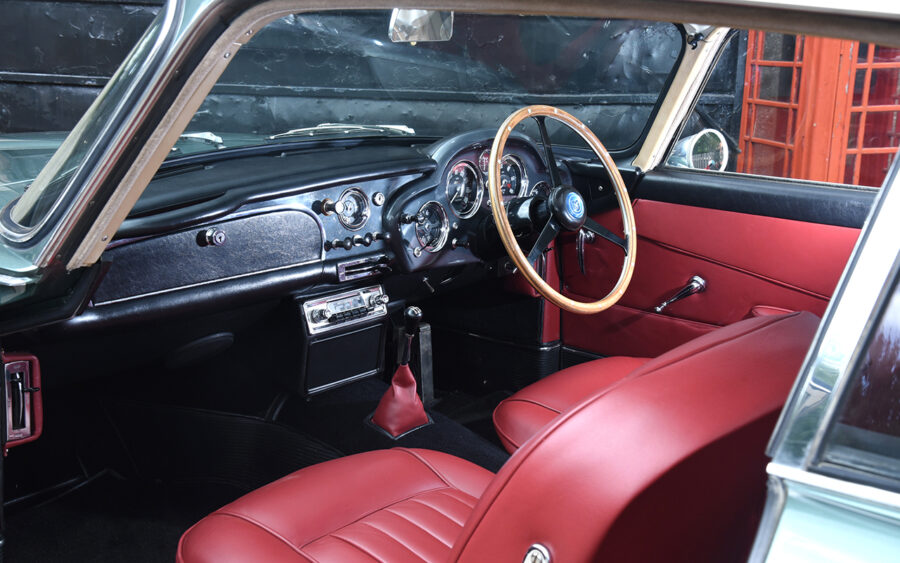
An Aston Martin DB4 Series V Vantage prototype was even used as a test car by the special effect designers of the 1964 James Bond film, Goldfinger, to make sure the various gadgets fitted by Q branch – including the ejector seat and machine guns – would fit into a DB5. It’s also rumoured this DB4 was used as a stunt car, briefly appearing in the film.
Priced at £4,170 in 1963, only well-paid MI5 agents could afford an Aston Martin DB4 Series V Vantage. To put that figure into perspective, a Jaguar E-type 3.8 fixedhead coupe was over £2,000 less yet still offered a solid performance and beautiful design.
But an Aston Martin DB4 has something most Jaguars lack; exclusivity since a mere 55 DB4 Series Vs were produced with a tiny handful being to Vantage spec. This rarity also means it’s often been overshadowed by its more famous replacement, meaning the car’s impact on Aston and the subsequent design of its cars has often been overlooked. Until now.
I have to admit, when I arrive at Classic & Sportscar Centre’s premises in Malton, North Yorkshire, and see the beautiful metallic green example I’ve arranged to drive, even I think it’s a DB5. Of course, as one of the most iconic cars in the world, similar to me being mistaken for David Gandy, that’s not a bad thing but doesn’t tell the whole story.
An original UK right-hand-drive car, this particular Aston Martin DB4 was delivered new on the 30th November 1962 by Aberfoyle Motors in Scotland to a Mr G Scarth who lived locally in Perthshire. It was kept by its first owner for over two decades, who sold it in 1985 through a London-based dealer with only 35k miles on the clock. The car was restored in the Nineties and again in 2017 resulting in the immaculate example in front of me.
With perfect proportions, beautiful detailing and an imposing stance, it’s easy to understand why it’s become the most famous of all Aston Martin’s designs and why it continues to have an impact. It’s not a DB2 or DBS that influenced the DB11 but rather this car. The interior is close to automotive perfection. With no clichéd wood veneer like other cars of the period, the large array of classic white-on-black dials grouped around the steering column are inset into a dashboard of Bakelite. The swooping shape of the dash gives it an almost art-deco look that would continue through to the DB6.
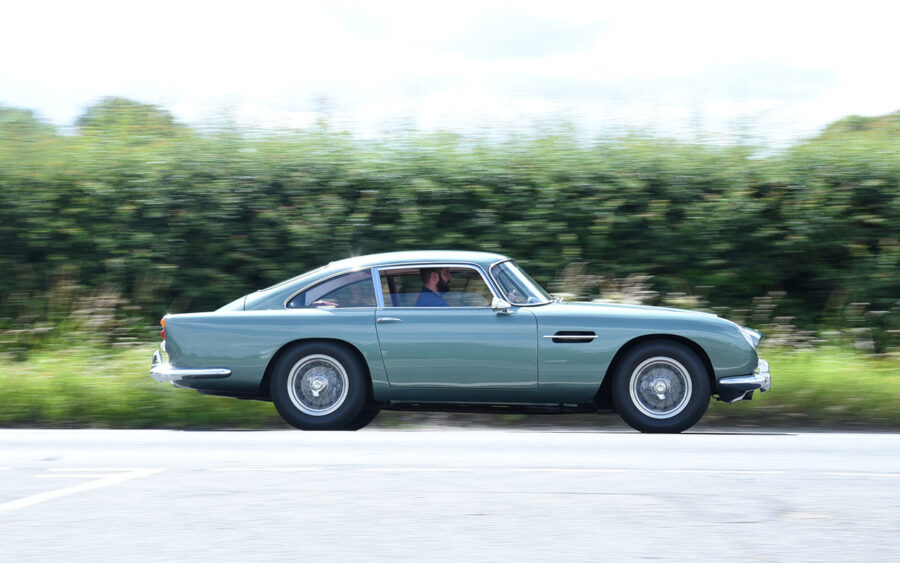
Time to take this magnificent beast for a drive. The straight-six engine starts immediately before settling down to the familiar gruff note at idle. After putting the four-speed manual gearbox manufactured by parent company David Brown into first, I release the surprisingly progressive clutch and begin to move. Other than I could listen to the twin-cam roar of the engine all day, my first impression is that it doesn’t feel all that fast even by the standards of the day and I’m sure an E-type 3.8 would beat it in a dash to 60. Yet the easy revving nature of the engine makes up for any lack of power and it’s not difficult to get the best from it, aided by the four-speed manual transmission that feels slick and easy to operate.
As with many cars of the era, the rack-and-pinion steering can feel vague at times, and I need all my concentration to keep the car in a straight line. Plus, unlike other performance models of the time such as the E-type and Mercedes-Benz SL, the Aston Martin DB4 doesn’t have independent rear suspension. The car was originally supposed to have a De Dion rear end, but this was swapped for an old-fashioned live axle at the last minute since Aston couldn’t find a supply of enough final drive units suitable for mounting onto the Superleggera chassis. This results in the DB4 lacking the nimbleness the other two possess, meaning it drives like a much older machine, reminding me more of a DB2/4.
Yet as I look down that long, voluptuous bonnet that’s dominated by the wide power bulge and hear the atmospheric growl of the 3.7-litre straight-six, driving a DB4 Vantage is an experience few, if any, European cars from the time can match. The last time I enjoyed this kind of visceral excitement was when I drove a majestic Lamborghini 350 GT 20 years ago.
The DB5 might be better well-known due to its many onscreen escapades but due to the DB4 Series V Vantage setting the standard for it and all future models, there’s no denying the car’s importance in Aston Martin’s long and distinguished history.

